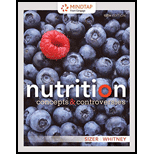
NUTRITION-MINDTAP (1 TERM)
15th Edition
ISBN: 9781337907101
Author: Sizer
Publisher: CENGAGE L
expand_more
expand_more
format_list_bulleted
Question
Chapter 10, Problem 10SC
Summary Introduction
Concept Introduction:
Myoglobin is the protein which makes up the muscles. It stretches and compress as per the movement of the body. It is similar in structure with hemoglobin. This protein is the smallest functional unit of muscles.
Expert Solution & Answer
Want to see the full answer?
Check out a sample textbook solution
Chapter 10 Solutions
NUTRITION-MINDTAP (1 TERM)
Ch. 10 - Prob. 1RQCh. 10 - Prob. 2RQCh. 10 - Prob. 3RQCh. 10 - Prob. 1SCCh. 10 - The length of time a person must spend exercising...Ch. 10 - Prob. 3SCCh. 10 - To overload a muscle is never productive. T FCh. 10 - Prob. 5SCCh. 10 - Prob. 6SCCh. 10 - Prob. 7SC
Ch. 10 - Prob. 8SCCh. 10 - Prob. 9SCCh. 10 - Prob. 10SCCh. 10 - All of the following statements concerning beer...Ch. 10 - Prob. 12SCCh. 10 - Prob. 13SCCh. 10 - Prob. 14SCCh. 10 - Prob. 15SCCh. 10 - Prob. 16SCCh. 10 - Prob. 17SCCh. 10 - Prob. 18SCCh. 10 - Prob. 19SCCh. 10 - Most of the time, the buyer is wasting his or her...Ch. 10 - Divide into two groups. One group will argue in...
Knowledge Booster
Learn more about
Need a deep-dive on the concept behind this application? Look no further. Learn more about this topic, health-nutrition and related others by exploring similar questions and additional content below.Similar questions
- Which of the following are most closely associated with oxygen transport? (a) red blood cells (b) platelets (c) neutrophils (d) basophils (e) lymphocytesarrow_forwardVital capacity is the _______. a. amount of hemoglobin in a red blood cell b. amount of time a person can hold his or her breath c. maximum amount of air a person can move in and out with one breath d. amount of oxygen in an exhalationarrow_forwardAfter oxygen diffuses into lung capillaries, it also diffuses into _______ and binds with _______. a. tissue fluid; red blood cells b. tissue fluid; carbon dioxide c. red blood cells; hemoglobin d. red blood cells; carbon dioxidearrow_forward
- A developing fetus gets oxygen from its mothers blood. Fetal capillaries run through pools of maternal blood in an organ called the placenta. As fetal blood runs through these capillaries, it exchanges substances with the maternal blood around the capillary. The hemoglobin made by a fetus is different than that made after birth. Fetal hemoglobin binds oxygen more strongly at low oxygen levels than normal hemoglobin. How would fetal hemoglobins somewhat higher affinity for oxygen benefit the fetus?arrow_forwardOxyhemoglobin forms by a chemical reaction between which of the following? hemoglobin and carbon dioxide carbonic anhydrase and carbon dioxide hemoglobin and oxygen carbonic anhydrase and oxygenarrow_forward_____________________ Plasmapheresis is the removal of whole blood from the body, separation of its cellular elements, and reinfusion of these cellular elements suspended in saline or a plasma substitute.arrow_forward
- Which of the following stimulates the production of erythrocytes? AMS high blood levels of carbon dioxide low atmospheric pressure erythropoietinarrow_forwardThe body loses water by way of the ________. a. skin b. lungs c. digestive system d. urinary system e. both c and d f. a through darrow_forwardBreathing _______. a. ventilates the lungs b. draws air into airways c. expels air from airways d. causes reversals in pressure gradients e. all of the abovearrow_forward
arrow_back_ios
arrow_forward_ios
Recommended textbooks for you
 Human Biology (MindTap Course List)BiologyISBN:9781305112100Author:Cecie Starr, Beverly McMillanPublisher:Cengage Learning
Human Biology (MindTap Course List)BiologyISBN:9781305112100Author:Cecie Starr, Beverly McMillanPublisher:Cengage Learning
 Human Physiology: From Cells to Systems (MindTap ...BiologyISBN:9781285866932Author:Lauralee SherwoodPublisher:Cengage Learning
Human Physiology: From Cells to Systems (MindTap ...BiologyISBN:9781285866932Author:Lauralee SherwoodPublisher:Cengage Learning




Human Biology (MindTap Course List)
Biology
ISBN:9781305112100
Author:Cecie Starr, Beverly McMillan
Publisher:Cengage Learning


Human Physiology: From Cells to Systems (MindTap ...
Biology
ISBN:9781285866932
Author:Lauralee Sherwood
Publisher:Cengage Learning
Bacterial Infections in Humans; Author: Professor Dave Explains;https://www.youtube.com/watch?v=FeFKAl9KyMg;License: Standard Youtube License